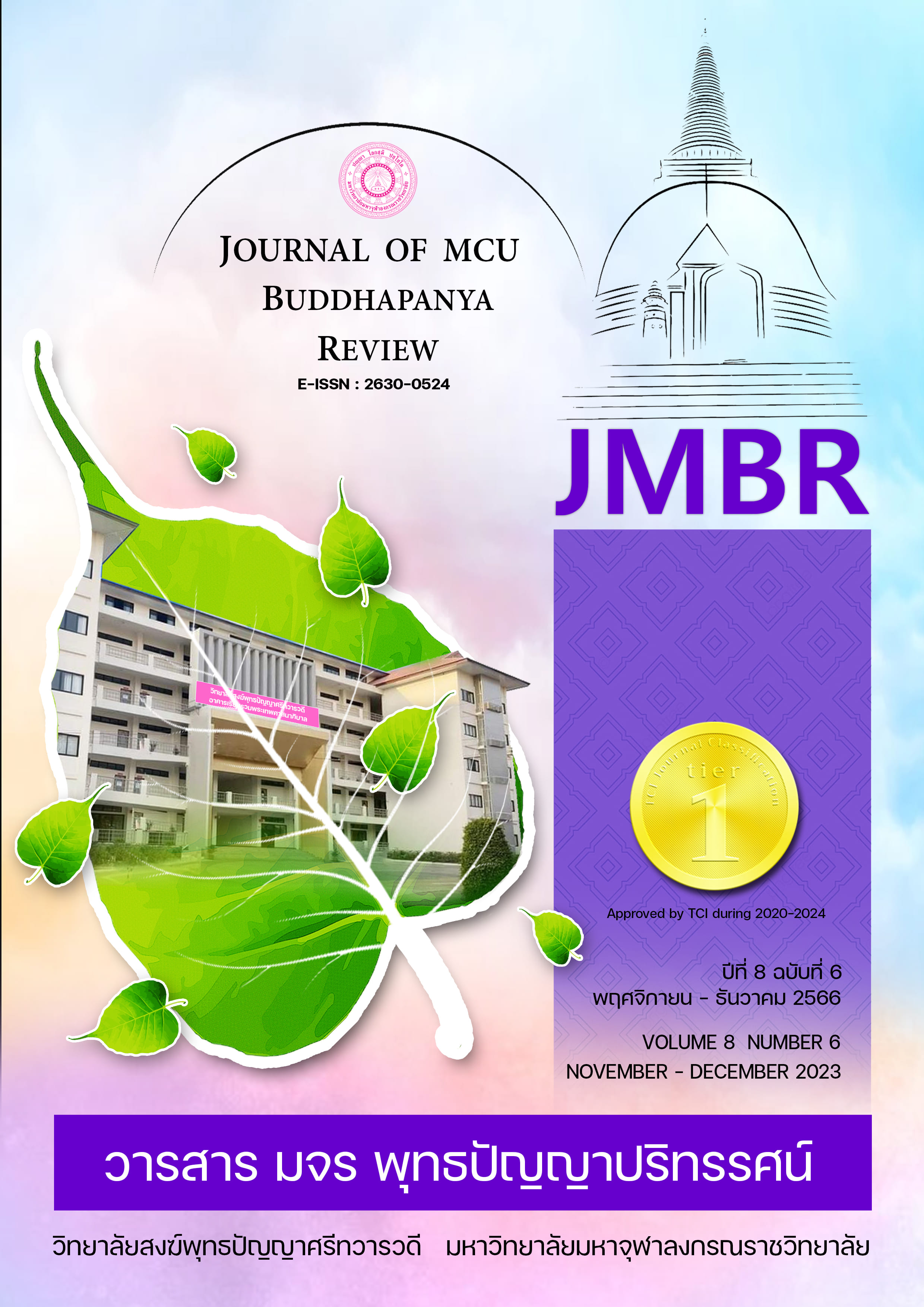การพัฒนารูปแบบสมรรถนะผู้บริหารสถานศึกษาในโรงเรียนมาตรฐานสากล เพื่อส่งเสริมพื้นที่นวัตกรรมการศึกษา
คำสำคัญ:
สมรรถนะผู้บริหาร, นวัตกรรมการศึกษา, โรงเรียนมาตรฐานสากลบทคัดย่อ
การวิจัยครั้งนี้มีวัตถุประสงค์เพื่อศึกษาองค์ประกอบของสมรรถนะ เพื่อพัฒนารูปแบบการพัฒนาสมรรถนะ และเพื่อประเมินรูปแบบการพัฒนาสมรรถนะผู้บริหารสถานศึกษาโรงเรียนมาตรฐานสากลเพื่อส่งเสริมพื้นที่นวัตกรรมการศึกษา กลุ่มตัวอย่างในการวิจัยครั้งนี้เป็นผู้บริหารสถานศึกษาที่อยู่ในพื้นที่นวัตกรรมการศึกษาตามพระราชบัญญัติพื้นที่นวัตกรรมการศึกษา พ.ศ.2562 จำนวน 350 คน ใช้ระเบียบวิธีการวิจัยแบบผสานวิธีเชิงอธิบายเป็นลำดับ และใช้เทคนิคเดลฟาย เครื่องมือที่ใช้ในการวิจัย คือ แบบสอบถามเกี่ยวกับความคิดเห็นที่มีต่อความถูกต้องและความเหมาะสม การวิเคราะห์ข้อมูลใช้โปรแกรมคอมพิวเตอร์ สถิติที่ใช้ คือ ความถี่ ร้อยละ ค่าเฉลี่ย (X) และส่วนเบี่ยงเบนมาตรฐาน (S.D.)
ผลการวิจัยปรากฏว่า 1.องค์ประกอบของสมรรถนะผู้บริหารสถานศึกษาในโรงเรียนมาตรฐานสากลเพื่อส่งเสริมพื้นที่นวัตกรรมการศึกษา ประกอบด้วยสมรรถนะ 3 ด้าน คือ 1) สมรรถนะส่วนบุคคล ประกอบด้วย ความเชี่ยวชาญในสายอาชีพ คุณธรรม แรงจูงใจมุ่งสัมฤทธิ์ การพัฒนาตนเอง และความคิดสร้างสรรค์ 2) สมรรถนะต่อองค์การ ประกอบด้วย การทำงานเป็นทีม ความเข้าใจในองค์กรและระบบราชการ การมีส่วนร่วม การประกันคุณภาพการศึกษา และเทคโนโลยีสารสนเทศ และ 3) สมรรถนะหลัก ประกอบด้วย การวิเคราะห์ สังเคราะห์ และการวิจัยเพื่อพัฒนาภาวะผู้นำ การวางแผน และการบริหารองค์กร 2.การพัฒนารูปแบบการพัฒนาสมรรถนะผู้บริหารสถานศึกษาโรงเรียนมาตรฐานสากลเพื่อส่งเสริมพื้นที่นวัตกรรมการศึกษา โดยใช้เทคนิคเดลฟายแบบปรับปรุงมี 3 องค์ประกอบ คือ 1) สมรรถนะผู้บริหารสถานศึกษา เป้าหมายของโรงเรียนมาตรฐาน และเป้าหมายการจัดการศึกษาพื้นที่นวัตกรรมการศึกษา 2) การจัดการเรียนเรียนตามเป้าหมายของโรงเรียนมาตรฐานและ 3) เป้าหมายการจัดการศึกษาพื้นที่นวัตกรรมการศึกษา และ 3.ประเมินรูปแบบการพัฒนาสมรรถนะผู้บริหารสถานศึกษาโรงเรียนมาตรฐานสากลเพื่อส่งเสริมพื้นที่นวัตกรรมการศึกษา พบว่า 1) ความถูกต้อง โดยรวมในระดับมากที่สุด และ 2) ความเหมาะสม โดยรวมในระดับมากที่สุด
เอกสารอ้างอิง
Anon Sakworawit. (2004). The concept of competency: an old story that we are still lost in, Chulalongkorn Review. 16(64)
Educational Innovation Area Act 2019. (2019, 30 April). Royal Gazette. Page 102.
Nawachon Somboonsin. (2021). Administrative innovation management model in basic educational institutions. Doctor of Philosophy in Educational Administration Naresuan University.
Office of the Basic Education Commission. (2010). Teacher competency assessment manual 2010. Bangkok.
Office of the Secretariat of the Education Council. (2016). Spatial education management model: alternative lessons. and conditions for success. Bangkok: Phrikwan Graphic Company Limited.
Office of the Civil Service Commission. (2005). Thai Civil Service Competency Manual. (1st revised edition). Bangkok: Man, Aid Media.
Office of the Permanent Secretary, Ministry of Education. (2014). Management competencies that create organizational acceptance. Accessible from http://www.krubannok.com/
Office for Educational Standards and Quality Assessment. (2016). Report on external quality assessment of educational institutions, round three (2011-2015), basic education level. Bangkok: Office for Educational Standards and Quality Assessment.
Phrakru Kittiyanwisit, Phrakru Wirun Sutakun Rawing Ruangsang and Sutit Sawadee. (2022). Study of guidelines for developing educational innovation areas. Faculty of Education, Mahachulalongkornrajavidyalaya University.
Policy and Planning Division Valayaalongkorn Rajabhat University. (2020). Royal Gazette published the Education Innovation Area Act 2019. Accessible from https://plan.vru.ac.th/?p=2992
The Secretariat of the Council of Education. (2020). Participation in Educational (Management of Civil Society Stakeholders under the National Education Bill B.E.). Bangkok: Prik Wan Graphic Co., Ltd.
Worachai Wipuuprakot. (2021). Organizing spatial education in the participatory management of basic educational institution administrators. Panyapiwat Journal, 13(3), 320-332
ดาวน์โหลด
เผยแพร่แล้ว
รูปแบบการอ้างอิง
ฉบับ
ประเภทบทความ
สัญญาอนุญาต
ลิขสิทธิ์ (c) 2023 วารสาร มจร พุทธปัญญาปริทรรศน์

อนุญาตภายใต้เงื่อนไข Creative Commons Attribution-NonCommercial-NoDerivatives 4.0 International License.



